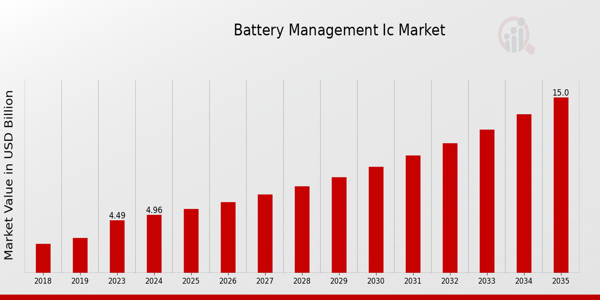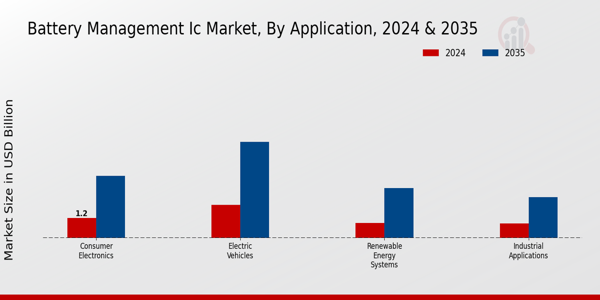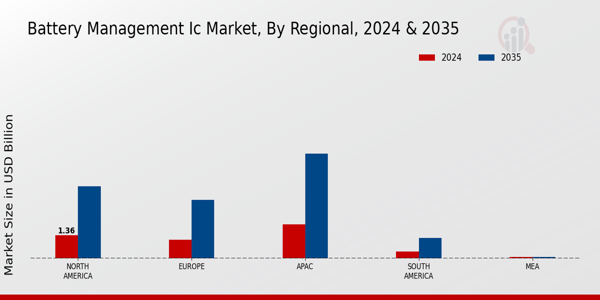Global Battery Management IC Market Overview
The Battery Management IC Market Size was estimated at 4.49 (USD Billion) in 2023. The Battery Management IC Market is expected to grow from 4.96 (USD Billion) in 2024 to 15.0 (USD Billion) by 2035. The Battery Management IC Market CAGR (growth rate) is expected to be around 10.58% during the forecast period (2025 - 2035).
Key Battery Management IC Market Trends Highlighted
The increase in global electric vehicle adoption, interest in renewable energy, and advances in energy storage systems are some of the key factors driving the Battery Management IC Market. The growing shift towards sustainable energy by various industries and consumers further propels the need for more sophisticated battery management systems. These systems, which optimize battery life, safety, and performance, are critical for a wide spectrum of applications, from consumer electronics to e-mobility. Moreover, the adoption of advanced communications and miniaturized battery management integrated circuits (ICs) are increasing in popularity due to their usefulness in several industries.
Opportunities abound in this evolving market, especially with the surge in electric vehicle production and the increasing need for smart grid technologies. Manufacturers can capitalize on innovations, such as integration with artificial intelligence, to enhance battery monitoring and management. The boom in renewable energy sources, like solar and wind, also creates chances to develop advanced battery management solutions that can store energy efficiently and leverage it when needed. Additionally, the growth in consumer electronics presents opportunities for designing customized battery management ICs tailored for specific applications, thus opening new revenue streams.
Recently, the market has seen trends focusing on miniaturization, IoT integration, and the rise of wireless battery management systems. The shift towards electric vehicles has heightened awareness about the importance of battery health, driving innovation in monitoring technologies. Furthermore, sustainability has led to the exploration of battery recycling technologies alongside management solutions. As research progresses, the incorporation of new chemistries and materials in battery systems is expected to generate fresh developments, ensuring the market remains dynamic and responsive to both consumer and industrial needs.

Source: Primary Research, Secondary Research, MRFR Database and Analyst Review
Battery Management IC Market Drivers
Growing Demand for Electric Vehicles (EVs)
The rapid increase in the demand for electric vehicles is one of the most significant drivers for the Battery Management IC Market. As more consumers seek eco-friendly alternatives to traditional fuel-powered cars, the electric vehicle market has begun to flourish. This shift is not only motivated by individual preferences but is also influenced by governmental policies and subsidies aimed at reducing carbon emissions and fostering sustainability.
Manufacturers are investing heavily in the development of advanced battery technologies to enhance battery performance, longevity, and safety, making effective battery management systems essential. Battery management ICs play a pivotal role in monitoring and optimizing battery usage, thereby maximizing the efficiency and effectiveness of electric vehicles. Furthermore, as technology evolves, the performance expectations for electric vehicle batteries are increasing, necessitating sophisticated battery management solutions.
This trend is expected to accelerate, reinforcing the position of battery management ICs as critical components in next-generation electric vehicle designs.
Advancements in Renewable Energy Storage Solutions
The growth of renewable energy sources, such as solar and wind, necessitates efficient energy storage solutions, driving demand for battery management ICs. As more businesses and households adopt renewable energy systems, the need for advanced battery technologies becomes paramount. The Battery Management IC Market benefits from this push towards sustainable energy, as effective battery management is vital for optimizing performance and longevity in energy storage systems.
Increased Adoption of Consumer Electronics
The proliferation of consumer electronics, including smartphones, laptops, and wearable devices, is another key driver for the Battery Management IC Market. As these devices become more advanced, their reliance on efficient and robust battery management systems increases. Manufacturers are striving to provide better solutions to improve battery life, safety, and performance, thereby enhancing user experience and satisfaction.
Battery Management IC Market Segment Insights
Battery Management IC Market Application Insights
The Battery Management IC Market, focusing on the Application segment, showcases a diverse landscape of valuation and growth trends among its key applications. As of 2024, the Consumer Electronics segment held a significant valuation of 1.2 USD Billion, growing to 3.75 USD Billion by 2035. This segment dominates the market due to the increasing demand for portable electronic devices such as smartphones, tablets, and wearables, necessitating innovative battery management solutions to enhance battery performance and life. Similarly, the Electric Vehicles segment has a notable valuation of 2.0 USD Billion in 2024, projected to rise to 5.8 USD Billion by 2035, underscoring the growing adoption of electric vehicles spurred by environmental concerns and advancements in electric vehicle technology. This segment is critical as it represents the shift towards sustainable transportation, thus driving the demand for efficient battery management systems.
In terms of Renewable Energy Systems, the market stood at 0.9 USD Billion in 2024, with a projected increase to 3.0 USD Billion by 2035, indicating a significant growth trajectory fueled by the global push for sustainable energy solutions. This application segment is vital as it supports the integration of renewable energy sources, optimizing energy storage and utilization. Lastly, the Industrial Applications segment, valued at 0.86 USD Billion in 2024 and anticipated to grow to 2.45 USD Billion by 2035, encompasses a variety of applications in sectors such as manufacturing and logistics. While this segment is currently the smallest, it presents notable opportunities for growth through automation and enhanced operational efficiencies. Overall, the insights into the Battery Management IC Market segmentation highlight a robust demand across various applications, underpinned by technological advancements and sustainability efforts, indicating a healthy and expanding market landscape.

Source: Primary Research, Secondary Research, MRFR Database and Analyst Review
Battery Management IC Market Type Insights
The Battery Management IC Market revenue reached 4.96 billion USD in 2024, showing significant growth potential as it moves towards an estimated value of 15.0 billion USD by 2035. This market segmentation includes various types, with a key focus on Cell Monitoring ICs, Battery Pack Protection ICs, Battery Balancing ICs, and Battery Management Systems. Cell Monitoring ICs are crucial as they provide real-time data on individual cell performance, ensuring optimal battery output and longevity. Battery Pack Protection ICs play a significant role in safeguarding against overcharging and short circuits, contributing to the safety and reliability of battery packs.
Battery Balancing ICs are needed for maximizing energy efficiency, as they maintain uniform charge levels across battery cells, while Battery Management Systems are essential for overall management and control, facilitating communication between components. The demand for these types is driven by the growing adoption of electric vehicles and renewable energy storage solutions, making it a dynamic area of the market. Despite growth opportunities, challenges such as technological advancements and the need for cost-effective solutions remain essential considerations for stakeholders within the Battery Management IC Market.
Battery Management IC Market End-Use Insights
The Battery Management IC Market, valued at 4.96 USD Billion in 2024, is experiencing notable growth across various end-use applications, which significantly influences the overall market dynamics. This includes key sectors such as Automotive, Telecommunications, Healthcare, and Aerospace. The Automotive segment plays a crucial role as electric vehicles gain popularity, necessitating efficient energy management systems. Similarly, the Telecommunications sector benefits from advancements in battery technology, supporting the increased demand for energy-efficient solutions amid the rise of 5G networks.
In Healthcare, battery management ICs ensure the reliability of medical devices, contributing to patient safety and operational efficiency. The Aerospace sector requires robust energy management solutions to enhance the performance and safety of airborne systems. Driven by these applications, the Battery Management IC Market segmentation illustrates a diverse landscape that is poised for sustained market growth. Market trends indicate a continuous shift towards innovation and enhanced functionality, addressing challenges such as energy efficiency.
The Battery Management IC Market data reflects ongoing opportunities for advancements in battery technology, underscoring the industry's evolution and potential profitability in the upcoming years.
Battery Management IC Market Technology Insights
The Battery Management IC Market, particularly within the technology segment, showcased a valuation of 4.96 billion USD in 2024 and is projected to reach 15.0 billion USD by 2035. This segment is crucial as it oversees the lifecycle and performance of various battery types. Among these, Lithium-ion technology dominates the market due to its extensive application in consumer electronics and electric vehicles, providing efficiency and longevity. Nickel-based batteries, known for their reliability, are also significant in power tools and hybrid vehicles.
Lead Acid batteries, despite being older technology, remain in demand for automotive applications due to their cost-effectiveness and robustness. Solid-state batteries are emerging as a vital component in improving energy density and safety, reflecting the industry's trend toward advanced battery solutions. The overall market growth is driven by increasing demand for electric vehicles, renewable energy storage, and advancements in battery technology, while challenges include supply chain issues and raw material scarcity. Understanding the Battery Management IC Market segmentation sheds light on how these various technologies contribute to the industry's expansion and ongoing innovations.
Battery Management IC Market Regional Insights
The Regional analysis of the Battery Management IC Market highlights significant growth and diversity across various areas. In 2024, North America held a valuation of 1.36 USD Billion, which is expected to grow to 4.2 USD Billion by 2035, showcasing its majority holding in the market, driven by technological advancements and a robust electric vehicle sector. Europe follows closely with a market value of 1.1 USD Billion in 2024, rising to 3.4 USD Billion in 2035, as it emphasizes renewable energy and battery storage solutions. The APAC region shows substantial potential, being valued at 2.0 USD Billion in 2024 and anticipated to reach 6.1 USD Billion by 2035, largely due to the increasing demand for consumer electronics and electric vehicles.
In South America, the market size is relatively smaller, with valuations of 0.4 USD Billion in 2024 and rising to 1.2 USD Billion in 2035, suggesting emerging opportunities within the renewable energy space. The MEA region remains the least, valued at 0.1 USD Billion both in 2024 and 2035, indicating an underdeveloped but potentially growing market influenced by future investments in battery technology. Overall, the Battery Management IC Market showcases diverse growth drivers across regions, with North America and APAC being particularly significant in terms of market revenue.

Source: Primary Research, Secondary Research, MRFR Database and Analyst Review
Battery Management IC Market Key Players and Competitive Insights
The Battery Management IC Market has been witnessing significant growth driven by the increasing demand for efficient energy storage solutions across various applications. The competitive landscape of this market is characterized by a multiplicity of players, all striving to innovate and enhance their product offerings. Key factors such as technological advancements, growing consumer electronics, electric vehicles, and renewable energy sources are propelling the need for sophisticated battery management systems. Companies operating in this space are focusing on product differentiation, strategic collaborations, and mergers and acquisitions to strengthen their market presence and gain a competitive edge. With the rise in battery-powered devices and the push for sustainable energy solutions, the market for battery management integrated circuits is expected to evolve rapidly, making competitive insights crucial for understanding future trends and opportunities.
Infineon Technologies has established itself as a significant player in the Battery Management IC Market through its strong focus on innovation and high-performance semiconductor solutions. The company offers a comprehensive range of battery management ICs that cater to various applications, including electric vehicles and renewable energy systems. Infineon's strengths lie in its extensive research and development capabilities, enabling the creation of advanced technologies that enhance the efficiency and reliability of battery management systems. Furthermore, its commitment to sustainability aligns well with the global drive towards greener technologies, making Infineon a frontrunner in this market segment. The company's robust supply chain and strong relationships with key stakeholders further bolster its competitive advantage, allowing it to respond effectively to market demands while maintaining high-quality standards.
Vicor Corporation is another prominent player in the Battery Management IC Market, recognized for its cutting-edge power solutions that effectively manage battery performance. The company's innovative approach to power management has allowed it to carve out a niche in this highly competitive space. Vicor's battery management ICs are designed to optimize the performance of battery systems, ensuring maximum efficiency, safety, and longevity. With a strong emphasis on modular power architecture, Vicor is well-positioned to address the evolving demands of various industries, including the automotive and industrial sectors. Its adeptness at integrating new technologies into its product line, coupled with a customer-centric approach, enhances its market presence. Vicor's strategic roadmap focuses on harnessing emerging technologies to cater to the intricate requirements of battery management, thus enabling sustained growth in its market segment.
Key Companies in the Battery Management IC Market Include:
- Infineon Technologies
- Vicor Corporation
- ROHM Semiconductor
- STMicroelectronics
- Broadcom Inc
- Intersil Corporation
- Maxim Integrated
- Renesas Electronics
- Microchip Technology
- Samsung Electronics
- Semtech Corporation
- Texas Instruments
- ON Semiconductor
- Analog Devices
- NXP Semiconductors
Battery Management IC Industry Developments
The Battery Management IC Market has recently seen significant developments, particularly with companies like Infineon Technologies and STMicroelectronics enhancing their product portfolios to meet the growing demand for electric vehicles and renewable energy solutions. The rise of electric mobility has led to an increased focus on efficient battery management systems, benefiting firms such as Texas Instruments and Microchip Technology, which are expanding their offerings in this realm. Furthermore, ROHM Semiconductor and NXP Semiconductors are actively investing in research and development to create advanced battery management solutions that cater to the evolving requirements of various applications, including consumer electronics and industrial uses. In terms of market activities, there have been notable mergers and acquisitions, such as ON Semiconductor acquiring a leading player in the semiconductor space, bolstering its position in battery management technology. Additionally, Analog Devices has been working on collaborations that enhance its market standing. As global demand for energy storage solutions rises, companies like Samsung Electronics and Semtech Corporation are capitalizing on this trend, pushing for innovations that are expected to increase their market valuation and influence in the Battery Management IC sector.
Battery Management IC Market Segmentation Insights
-
Battery Management IC Market Application Outlook
- Consumer Electronics
- Electric Vehicles
- Renewable Energy Systems
- Industrial Applications
-
Battery Management IC Market Type Outlook
- Cell Monitoring ICs
- Battery Pack Protection ICs
- Battery Balancing ICs
- Battery Management Systems
-
Battery Management IC Market End-Use Outlook
- Automotive
- Telecommunications
- Healthcare
- Aerospace
-
Battery Management IC Market Technology Outlook
- Lithium-ion
- Nickel-based
- Lead Acid
- Solid-state
-
Battery Management IC Market Regional Outlook
- North America
- Europe
- South America
- Asia-Pacific
- Middle East and Africa
| Report Attribute/Metric |
Details |
| Market Size 2023 |
4.49 (USD Billion) |
| Market Size 2024 |
4.96 (USD Billion) |
| Market Size 2035 |
15.0 (USD Billion) |
| Compound Annual Growth Rate (CAGR) |
10.58% (2025 - 2035) |
| Report Coverage |
Revenue Forecast, Competitive Landscape, Growth Factors, and Trends |
| Base Year |
2024 |
| Market Forecast Period |
2025 - 2035 |
| Historical Data |
2019 - 2023 |
| Market Forecast Units |
USD Billion |
| Key Companies Profiled |
Infineon Technologies, Vicor Corporation, ROHM Semiconductor, STMicroelectronics, Broadcom Inc, Intersil Corporation, Maxim Integrated, Renesas Electronics, Microchip Technology, Samsung Electronics, Semtech Corporation, Texas Instruments, ON Semiconductor, Analog Devices, NXP Semiconductors |
| Segments Covered |
Application, Type, End Use, Technology, Regional |
| Key Market Opportunities |
Growing demand for electric vehicles, Expansion of renewable energy storage, Advancements in battery technology, Increasing consumer electronics usage, Rising focus on energy efficiency |
| Key Market Dynamics |
Growing electric vehicle adoption, Increasing renewable energy integration, Rising demand for portable electronics, Technological advancements in BMS, Stricter safety regulations |
| Countries Covered |
North America, Europe, APAC, South America, MEA |
Frequently Asked Questions (FAQ) :
The Battery Management IC Market was valued at 4.96 USD Billion in 2024.
By 2035, the Battery Management IC Market is projected to reach a valuation of 15.0 USD Billion.
The anticipated CAGR for the Battery Management IC Market from 2025 to 2035 is 10.58%.
The market size for the APAC region is expected to grow to 6.1 USD Billion by 2035.
In 2035, the Renewable Energy Systems segment is expected to reach a market value of 3.0 USD Billion.
Major players in the Battery Management IC Market include Infineon Technologies, STMicroelectronics, Texas Instruments, and Samsung Electronics.
The market size for Industrial Applications in 2035 is anticipated to be 2.45 USD Billion.
















